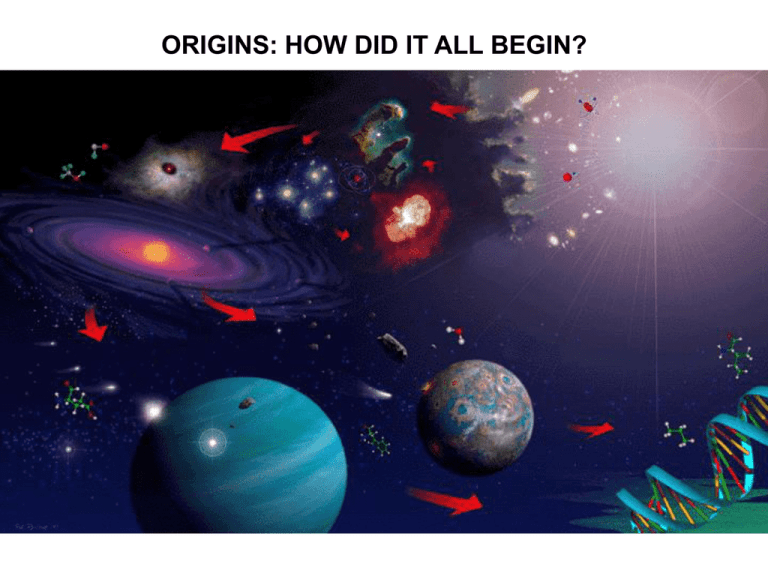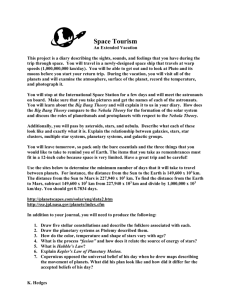ORIGINS: HOW DID IT ALL BEGIN?
advertisement

ORIGINS: HOW DID IT ALL BEGIN? ORIGINS: HOW DID IT ALL BEGIN? • The topic of Origins is perhaps the largest of all imaginable topics of scientific research, as it includes everything (both matter and energy) that we know, or expect, that exists in our universe. • The following topics, in order of both size and time, are included in the broader topic of Origins: 1. Origin and Evolution of the Universe 2. The Origin of the Solar System 3. Formation and Early History of Earth 4. Geologic Time and the Rock Record 5. The Chemistry and Origin of Life IN THE BEGINNING: THE ORIGIN AND EVOLUTION OF THE UNIVERSE • The age of the Universe was not well established until recently, but is now thought to be about 13.7 billion years, or about 3 times the age of our Solar System. • The Universe is thought to have originated in a point-like concentration, which began expanding outward in a “Big Bang” at the speed of light. • At the initial temperature and pressure of the early Universe, matter existed only as elementary particles. Only after a million years or so of expansion, did the matter cool enough to form atoms as we know them today (mostly hydrogen and helium). IN THE BEGINNING: THE ORIGIN AND EVOLUTION OF THE UNIVERSE • As the Universe expanded and cooled, the material concentrated in individual clumps which formed protogalaxies. • Within the proto-galaxies, the gas further congregated into many smaller and denser clumps which in turn condensed to form stars. • These original stars, like our Sun and other stars today, generated heat and light by the fusion of hydrogen atoms to form helium, and in turn, still heavier elements. The above diagram is intended only to show, in much simplified form, the expansion of the Universe, at a maximum speed equal to that of light, since its origin about 13.7 billion years ago. In actuality, we cannot define an “outer edge” of the Universe. No matter where we are in the Universe, it will appear that we are at the center of the expansion- the “cosmological principle”. IN THE BEGINNING: THE ORIGIN AND EVOLUTION OF THE UNIVERSE • The first generation of stars, made up of almost pure hydrogen and helium, were much more massive, on the average, than stars forming at the present time. • These very massive first-generation stars evolved much more rapidly than the average of new stars today, and at the ends of their lives formed heavier elements (such as carbon, oxygen, silicon, and iron), which were then returned to the interstellar medium in supernova explosions. • Following generations of stars were formed from interstellar material increasingly richer in these heavy elements. THE ENERGY SOURCES OF STARS • Stars, including our Sun, derive their energy from a source much more efficient than ordinary chemical reactions (such as combustion): namely, thermonuclear fusion of the nuclei of light atoms to form nuclei of heavier ones. • The primary source of energy through the normal lifetimes of stars is the fusion of four hydrogen atom nuclei (protons) to form the nucleus of one helium atom (two protons and two neutrons). • Albert Einstein postulated, as part of his Theory of Relativity, that matter can be converted to energy (and vice versa) by the relationship, E = mc2 (where c = the speed of light = 300,000 kilometers per second). • The helium nucleus is only slightly less massive than the four protons combined to make it, but this difference results in the release of an enormous amount of energy! THE ENERGY SOURCES OF STARS • The mass of a Hydrogen Atom is 1.007825 AMU (Atomic Mass Units) • The mass of a Neutron is 1.008665 AMU • The mass of 2 H + 2 n is 4.032980 AMU • The mass of a Helium Atom is only 4.002603 AMU. We are missing 0.030377 AMU! • According to Einstein, the energy equivalent of matter is: Energy = Mass x (Speed of Light)2, or E = mc2. • Therefore, 1 AMU = 931.5 MeV (million electron volts) and the mass deficiency of 4H He = 28.3 MeV, compared with 2 H2 + O2 2 H2O = 5 eV! THE ENERGY SOURCES OF THE SUN AND STARS • Hydrogen constitutes about 90% of all the atoms in the Sun and in newly forming stars. • Helium is the next most abundant (about 9%); all heaver elements constitute about 1% (by number of atoms). • The Sun’s original supply of hydrogen is sufficient to supply its energy output for 10 billion years, or more than double its current age of 4.6 billion years. • When stars deplete their supplies of hydrogen (in their central cores), helium is fused to form still heavier elements - but, this process is much less efficient than hydrogen fusion, and so this energy source lasts for only a relatively short time. • Stars end their lives in a variety of ways, depending on their initial masses, which return much of the star’s mass to the interstellar medium, enriching it in heavier elements. COSMIC ABUNDANCES OF THE ELEMENTS (By Number of Atoms) Hydrogen Helium Oxygen Neon Carbon Nitrogen Silicon H He O Ne C N Si 106 105 890 500 400 110 32 Iron Magnesium Sulfur Argon Sodium Aluminum Calcium Fe Mg S Ar Na Al Ca 20-30 25 22 7.8 2 1.7 1.6 THE ORIGIN OF THE SOLAR SYSTEM • The age of the solar system is believed, from several lines of evidence, to be about 4.6 billion years. • The solar system was created by gravitational collapse of a cloud of interstellar material, consisting of gas and solid dust particles. • Observations with the Hubble Space Telescope and other spaceand ground-based instruments have shown that this process of star (and planet) formation is still going on at the present time elsewhere in our Galaxy. • The heavy elements in Earth and the other members of the solar system were manufactured in previous generations of stars, which exploded as supernovas at the ends of their lives. • Observations of regions of star and planetary system formation occurring presently, elsewhere in our galaxy, and recent detections of planets orbiting other stars, have added greatly to our understanding of how our own solar system was created, and its early evolution. THE ORIGIN OF THE SOLAR SYSTEM Conservation of Angular Momentum • A basic principle of physics is the law of Conservation of Momentum, = mass x velocity (M =mv). • Momentum of an object cannot change unless it is subjected to an Impulse, = Force x Time: Change of Momentum mv = Ft. • Also conserved is the Angular Momentum: L mv r mvr • where m = mass,v = velocity of motion around a center (such as the motion of a planet around the sun), and r = radius of the orbit (or other path) around the center. ( vis the component of the total vector velocity, v, which is perpendicular to r.) • A consequence of this latter law is that if a large, slowly rotating, spherical gas cloud contracts under its own gravitational force, its rotational velocity increases as it gets smaller, and it tends to change shape from a sphere to a flat disk. ORIGINS OF STARS AND PLANETS • In recent times, we have been able to detect new stars and planetary systems in the process of formation. • The Hubble Space Telescope, in particular, has observed new stars and planetary systems in the early stages of formation, in the region of the Orion Nebula (in the “sword” of the constellation Orion). • The observations of these newly forming planetary systems are consistent with the processes illustrated in the previous slides. • In addition, observations elsewhere in the sky have confirmed that other stars have planets or planetary systems. • Most of these are much larger and more massive than our Earth (or, in many cases, even Jupiter), but improvements in instrumentation technologies are expected to eventually reveal Earth-like planets as well. The Orion Nebula (Ground-Based Telescopic Image) HST View of the Orion Nebula Central Region Protoplanetary disks in the Orion Nebula, observed with the Hubble Space Telescope’s Wide Field/Planetary Camera-2. THE ORIGIN OF THE SOLAR SYSTEM • This process of star and planet formation is a continuing process, in our own and other galaxies, even at the present time. • Observations of star and planet formation elsewhere at present, helps us to understand the creation and early evolution of our solar system. • Also, study and exploration of our Moon, the other planets, comets, and asteroids in our solar system (which were all formed at the same time as our Earth), help us to better understand the origin and evolution of Earth. • In particular, the comets and the giant outer planets are more representative of the original materials from which the planets were formed, than are the inner planets such as our Earth. Model of the Origin of the Solar System From “How Comets are Made”, Joseph H. Nuth III, American Scientist, May-June 2001 FORMATION AND EARLY HISTORY OF THE SOLAR SYSTEM • The Earth and the other planets of our solar system are believed to have all formed about the same time as the Sun itself, from the leftover portions of the cloud of gas and dust from which the Sun formed. • The conditions in the leftover material were a strong function of distance from the newly forming Sun, because the temperature in the gas cloud determined the extent to which volatile materials, such as water, were able to condense. • The sizes of the originally forming protoplanets also affected the degree to which each could capture non-condensible materials, such as hydrogen and helium. • As a result, as observed in our present-day solar system, the compositions of the planets and their satellites depend both on their sizes and their distances from the Sun (as well as other factors, some of which are still poorly known). FORMATION AND EARLY HISTORY OF THE SOLAR SYSTEM • It is believed that the formation of planets began with accumulations of solid particles (such as water ice, and dust particles made up of elements such as carbon, silicon, and iron), which are known to exist today in dense regions of the interstellar medium. • Collisions between these particles built up larger “dust balls” which in turn collided with each other to build up ever larger accumulations. • When these protoplanetary objects reached a size that their own gravitational force was significant, they became more efficient at collecting additional dust particles and by colliding with each other, building up ever larger objects. • Sufficiently massive protoplanets, forming in the cooler, outer regions of the solar system, could also accrete gaseous material from the space within the solar system. How a planet forms. The process begins when dust grains collide and stick together, forming larger and larger clumps (A). The clumps move toward the central plane of the nebula (B) and collect into bodies the size of asteroids (C). These bodies gravitate into clusters (D), collide (E), and form the nucleus of a planet (F). The planet grows (G), and as its mass increases, it may attract gas from the nebula (H). If the planet is large enough, it may attract so much gas and draw it in so closely that the gas forms a dense shell representing most of the planetary mass (I). (From A. G. W. Cameron, “The Origin and Evolution of the Solar System”, Scientific American, 1975. From Stanley, Earth and Life through Time, 1989 FORMATION OF THE OUTER PLANETS • The outer planets (Jupiter, Saturn, Uranus, and Neptune) are quite different in composition from the inner, terrestrial planets (Mercury, Venus, Earth, and Mars), mainly because they formed in a region of space that was cool enough for water vapor and other hydrogen compounds to condense. • This allowed these planets to grow to a greater extent, and to have a much larger percentage of hydrogen, the hydrogen compounds, and helium, than the inner, terrestrial planets. • The two largest planets, Jupiter and Saturn, are much more similar in composition to the Sun, than to the terrestrial planets. • The two outer giant planets, Uranus and Neptune, are of intermediate composition, vs. the two largest planets and the terrestrial planets. • These differences can, in principle, be accounted for by a combination of local temperatures (distance from the Sun), initial density of the gaseous material vs. distance from the Sun, and the masses of the original heavy-element cores upon the lower density material was collected. FORMATION AND EARLY HISTORY OF EARTH • The Earth, and other inner (terrestrial) planets of our Solar System, are made up primarily of heavy elements (such as oxygen, silicon, and iron). • This was due to their lower initial masses, and higher temperatures, which made them unable to incorporate the light gases, hydrogen and helium. • These heavy elements formed the solid particle (dust) component of the interstellar material from which the solar system was created. • The inner planets were built up by the accumulation of dust into planetesimals, which in turn combined with each other to build up the planets. • Therefore, the composition of our Earth is quite different from those of the Sun, the giant outer planets, and the interstellar medium. RELATIVE ABUNDANCES OF THE ELEMENTS IN THE WHOLE EARTH (Percent by Number of Atoms) Oxygen Iron Silicon Magnesium Sulfur Nickel Aluminum Sodium Calcium Phosphorus O Fe Si Mg S Ni Al Na Ca P 48.86 18.84 13.96 12.42 1.39 1.39 1.31 0.64 0.46 0.14 Hydrogen Chromium Carbon Potassium Manganese Cobalt Chlorine Titanium All Others H Cr C K Mn Co Cl Ti 0.12 0.11 0.10 0.05 0.05 0.05 0.03 0.03 0.04 Compare with Chart, Cosmic Abundances of the Elements FORMATION AND EARLY HISTORY OF EARTH • As the Earth grew larger, its increasing gravity caused incoming particles to collide at increasingly higher speeds, and to produce greater amounts of heating due to their energies of impact. • In addition, heat generation by radioactive elements in the early Earth helped raise its temperature, and is still an important heat source at present. • When Earth’s interior heated to the melting point, heavy materials such as iron concentrated in a central core. • Outgassing of the molten early Earth released water vapor and other gases which later formed the oceans and atmosphere. RELATIVE ABUNDANCES OF THE ELEMENTS IN THE EARTH (By Weight) • WHOLE EARTH Fe 0.35 O 0.30 Si 0.15 Mg 0.13 Ni 0.024 S 0.019 Ca 0.011 Al 0.011 Other <0.01 • EARTH’S CRUST O 0.46 Si 0.28 Al 0.08 Fe 0.06 Mg 0.04 Ca 0.024 K 0.023 Na 0.021 Other <0.01 Origin and Early History of Earth Three mechanisms that would cause the early Earth to heat up: (a) In accretion, impacting bodies bombard the Earth and their energy of motion is converted to heat. (b) Gravitational compression of the Earth into a smaller volume causes its interior to heat up. (c) Disintegration of radioactive elements releases particles and radiation, which are absorbed by the surrounding rock, heating it. From Earth (3rd Edition), Press & Sevier, W. H. Freeman & Co., Publisher (1982) GEOLOGIC TIME AND THE ROCK RECORD • Earth has existed for about 4.6 billion years. However, our knowledge of the details of conditions and events, is much less for earlier time periods than for more recent ones. • Methods for determining the ages of rock samples are: o Determining the relative concentrations of radioactive elements (such as uranium and thorium) and their daughter products (such as lead) o Noting the relative vertical positions of layers of rock, where such access is available (e.g., in the Grand Canyon) o Noting the presence of various types of fossils, where the time periods of existence of the corresponding life forms are known. FORMATION AND EARLY HISTORY OF EARTH • Earth’s original atmosphere was quite different from the present atmosphere; it probably consisted mostly of nitrogen (N2) and carbon dioxide (CO2) with lesser amounts of reduced gases such as carbon monoxide (CO), methane (CH4), ammonia (NH3) and hydrogen sulfide (H2S). • Water (H2O), currently mostly liquid in Earth’s oceans, has about 300 times the mass of Earth’s current atmosphere. If temperatures on the early Earth were sufficiently high, H2O would have been the primary constituent of the atmosphere (about 300 bars), followed by CO2 (70 to 90 bars). • Most of the original CO2 is now locked up in carbonate rocks, such as calcium carbonate (CaCO3), as a result of water erosion (as carbonic acid, H2CO3) of the original silicate rocks. • Both fossil and mineral evidence indicate that oxygen (O2) was only a minor constituent of the atmosphere for the first half of Earth’s existence (the Archean eon), and did not reach near-current levels until the Phanerozoic eon (beginning 600 million years ago). (The intervening time period is known as the Proterozoic eon.) Evolution of Oxygen Content of Earth’s Atmosphere From Earth (3rd Edition), Press & Sevier, W. H. Freeman & Co., Publisher (1982) Evolution of Life and the Earth’s Atmosphere




